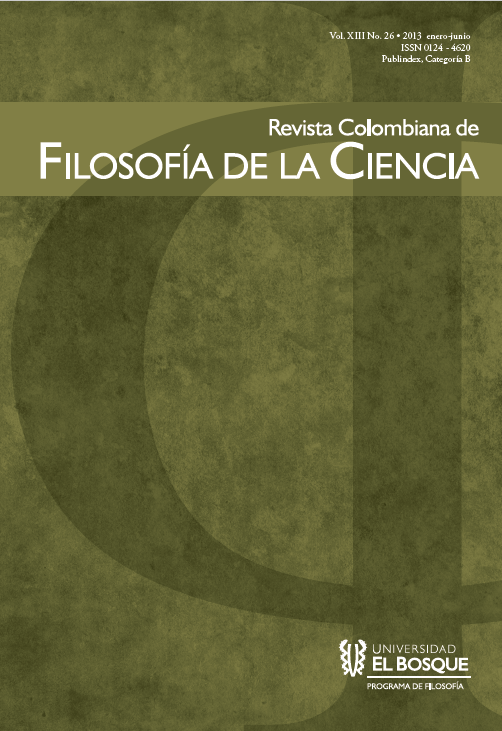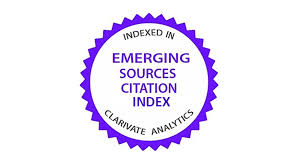Representación del sistema periódico: una tabla basada en tríadas
DOI:
https://doi.org/10.18270/rcfc.v13i26.1648Resumen
En este artículo presentaremos una representación del sistema periódico basada en dos
pilares fundamentales: las tríadas de número atómico y la concepción de los elementos
químicos como sustancias básicas. En la última década, la noción de tríada ha sido
rescatada y sugerida por Eric Scerri como posible criterio categorial para representar
la periodicidad química. Mediante esta representación, mostraremos como a través de
tríadas es posible reconstruir todas las relaciones entre los elementos que forman los
grupos del sistema periódico, sin apelar a las configuraciones electrónicas.
Descargas
Referencias bibliográficas
Bensaude-Vincent, B. “Mendeleiev: historia de un descubrimiento”. Historia
de las Ciencias. Ed. M. Serres. Madrid: Ediciones Cátedra, 1989. 503-525.
Bent, H. New Ideas in Chemistry from Fresh Energy for the Periodic Law, Bloomington:
AuthorHouse, 2006.
Clark, J.D. “A modern periodic chart of the chemical elements”. Science, 111
(1950): 661-663.
Earley, J. “How chemistry shifts horizons: element, substance, and the essential”.
Foundations of Chemistry, 11 (2009): 65-77.
Emerson, E.I. “A new spiral form of the periodic table”. Journal of Chemical
Education, 22 (1944): 111-115.
Hendry, R. “Substantial confusion”. Studies in History and Philosophy of
Science, 37 (2006): 322-336.
Janet, C. “The helicoidal classification of the elements”. Chemical News, 138
(1929): 372-374, 388-393.
Labarca, M. & Zambón, A. “Una reconceptualización del concepto de
elemento como base para una nueva representación del sistema periódico”.
Educación Química, 24 (2013): 63-70.
Laing, M. “The role of triads”. Journal of Chemical Education, 86 (2009):
-1184.
Ruthenberg, K. “Paneth, Kant and the philosophy of chemistry”. Foundations
of Chemistry, 11 (2009): 79-91.
Scerri, E. “Some aspects of the metaphysics of chemistry and the nature of
the elements”. HYLE – International Journal for Philosophy of Chemistry, 11
(2005): 127-145.
—. The Periodic Table – Its Story and Its Significance, New York: Oxford
University Press, 2007.
—. “The role of triads in the evolution of the periodic table: past and present”.
Journal of Chemical Education, 85 (2008a): 585-589.
—. “The past and future of the periodic table”. American Scientist, 96 (2008b):
-58.
—. “Which elements belong in group 3?”, Journal of Chemical Education, 86
(2009): 1188.
—. The Periodic Table. A Very Short Introduction, New York: Oxford
University Press, 2011.
—. “What is an element? What is the periodic table? And what does quantum
mechanics contribute to the question?”. Foundations of Chemistry, 14
(2012): 69-81
Schwarz, E. “Recommended questions on the roads towards a scientific explanation
of the periodic system of the chemical elements with the help of the
concepts of quantum physics”. Foundations of Chemistry, 9 (2007): 139-188.
Schwarz, E. & Rich, R. “Theoretical basis and correct explanation of the
periodic system: review and update”, Journal of Chemical Education, 4
(2010): 435-443.
Soddy, F. “Intra-atomic charge”. Nature, 92 (1913): 399-400.
Stewart, P. “A new image of the periodic table”, Education in Chemistry, 41
(2004): 156-158.
—. “A century on from Dimitri Mendeleev: tables and spirals, noble gases
and Nobel Prizes”, Foundations of Chemistry, 9 (2007): 235-245.
Von Antropoff, A. “Eine neue Form des periodischen Systems der Elementen”,
Zeitschrift für Angewandte Chemie, 39 (1926): 722–725.
Weisberg, M., Needham, P. & Hendry, R. “Philosophy of chemistry”. The
Stanford Encyclopedia of Philosophy. Ed. Edward N. Zalta. Winter 2011.
URL = <http://plato.stanford.edu/archives/win2011/entries/chemistry/>.
Descargas
Publicado
Cómo citar
Número
Sección

| Estadísticas de artículo | |
|---|---|
| Vistas de resúmenes | |
| Vistas de PDF | |
| Descargas de PDF | |
| Vistas de HTML | |
| Otras vistas | |











